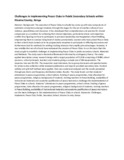Challenges in implementing peace clubs in public Secondary Schools within Kisumu County, Kenya
Date
2020-11Author
Owande, Joshua Oluoch
Okoth, Pontian Godfrey
Shiundu, John O.
Metadata
Show full item recordAbstract
Background: The execution of Peace Clubs in schools has come up with new components of optimistic
connections amongst students through the stages for the act of another culture of non-violence, peacefulness and
discourse. It has developed their comprehension and practice for shared compassion as a condition for achieving
their shared objectives, particularly where such objectives conflict thus figuring out how to participate in just
basic leadership and imaginative critical thinking, empowering them to oversee rising level of clashes
productively. Learners who have joined Peace Clubs in their schools have turned out to be progressively
receptive to participate in differing discussions and furthermore look for methods for settling clashing interests
that amplify joint advantages. However, it was notable that not all schools have embraced the creation of Peace
Clubs. Its on this basis that this study sought to establish challenges in implementing Peace Clubs in public
secondary schools.
Materials and Methods: The study used a theoretical framework informed by contingency theory. The study
applied descriptive survey research design with a target population of 91,834 comprising of BOM, school
sponsors, school principals, teachers and students giving a sample size of 584 respondents. The response rate
was 96.23%. The researcher used interviews, focus group discussion and questionnaires for primary data
collection while reviewed publications and reports provided secondary data. Content validity and split half
method were applied. Data was coded and analyzed and the results presented through pie charts and frequency
distribution tables.
Results: The study found out that students‟ attendance in peace programmes, school culture, funding of peace
programmes, time allocation for peace programmes, religious background of students, training teachers in Peace
Building, availability of instructional materials and academic qualification of peace instructors challenge the
implementation of Peace Clubs in schools. Students‟ attendance in peace programmes, school culture, funding
of peace programmes, time allocation for peace programmes, religious background of students, training teachers
in Peace Building, availability of instructional materials and academic qualification of peace instructors are the
main challenges to the implementation of Peace Clubs in schools.
URI
https://www.iosrjournals.org/iosr-jhss/papers/Vol.25-Issue11/Series-3/D2511032333.pdfhttp://ir-library.mmust.ac.ke:8080/xmlui/handle/123456789/1813
Collections
- Journal Articles [411]

